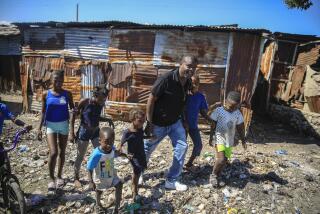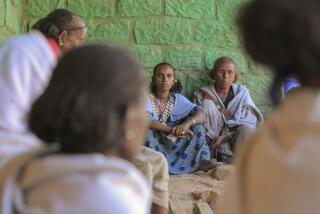Zaire on the Brink
- Share via
A cancer-stricken, absent strongman. A rebel army on the march. Ethnic warfare. Frightened, fleeing refguees by the hundreds of thousands. For months, the headlines have chronicled the tortuous slide of Zaire into paralysis and despair. Such chaos, of course, is hardly unique in Central Africa.
But, analysts warn, the consequences of a collapse in Zaire could be particularly severe because of the size and strategic importance of the giant nation to the Central African region.
BACKGROUND
Zaire, population 42 million, occupies an area as vast as the United States east of the Mississippi. It is potentially rich with diamonds, cobalt, gold, copper and other natural resources. Its immense rain forest hold the world’s largest reserve of tropical hardwood. Its huge rivers could provide electric power for much of Africa.
But Zaire’s economy has collapsed and its people are now among the continent’s poorest.
Meantime, they face endemic lawlessness and rampant corruption. Hyperinflation devours incomes. International financiers and Western donors, sick of seeing aid stolen, have suspended most of their assistance.
Many blame this baleful situation on Mobutu Sese Seko, 66, dictator of this sub-Saharan nation since 1965.
CONTENDING FORCES
Outside influences have long played a major role in Zairian strife. Belgian colonials created a fractious nation at the outset in the old Congo, which included more than 200 ethnic groups in its boundaries. Then, five years after his nation won independence from European control, Mobutu ended secessionist movements and armed revolts that threatened to split Zaire.
He garnered acclaim--but also quickly launched a personality cult, replete with ruthless repression, unbridled corruption and titanic ego.
The United States, seeing Mobutu as a rare African ally during the bitter Cold War years, propped him up. France, Belgium and other countries also sent troops to protect him.
But with the Soviet collapse and with Zaire’s steady impoverishment, opposition to Mobutu’s brutal, autocratic government has grown. A rebellion in the east--headed by long-time Mobutu nemesis Laurent Kabilia, an ethnic Tutsi--has been apparently fueled with assistance from neighboring Rwanda and with forces trained in Uganda.
As the rebels have seized more and more of the country--grabbing the No. 3 city, Kisangani, and potentially threatening resource-laden Shaba province and its capital, Lubumbashi, and diamond-producing Kasai province--Mobutu himself has been in and out of Zaire.
He suffers prostate cancer and has undergone treatment in Europe, where critics say he has spent some of his looted personal fortune on estates. When at home, he has shuffled his Cabinet. What little time he has spent recently in Zaire has been at his jungle redoubt in Gbadolite.
FORECAST
Mobutu’s health remains the huge question mark, with him in seclusion in Monaco and rumors rampant about the gravity of his illness.
What is left of his regime is in shambles, with the military in demoralized and in much disarray and the formal government in tatters; the prime minister, for example, was ousted this week, but the constitutionality of the move has been questioned. There have been reports that Mobutu’s family has left the country.
Still, it is unclear whether the rebels, who have the momentum, can topple Mobutu.
Analysts are watching closely to see whether their campaign shifts from Kisangani to Shaba province.
Meantime, there has been growing concern about stability in the region, as the conflict in Zaire worsens already tense ethnic emnities, particularly those between Hutus and Tutsis, whose bloody conflicts in neighboring Rwanda and Burundi have claimed hundreds of thousands of lives.
The rebels have already swept hundreds of thousands of Rwandan and Burundian refugees--Hutus--from eastern Zaire back to their homelands, creating new woes in those nations.
And, as the crisis grows in Kinshasa, aid agencies and government officials already are reporting an exodus from Zaire across the river to Brazzaville in the Congo.
The mayhem in Zaire also raises global concerns, as mercenary forces are playing a role. Besides combatants with links to Rwanda, Burundi and Uganda, there also have been reports of soldiers from Somalia, Sudan, Belgium, France, Israel and Serbia taking part in the conflict.
ZAIRE’S COLLAPSING ECONOMY
It’s people are impoverished ...
Real gross domestic product per capita
‘86: $213
‘96: $148
*
Its debt grows ...
Total external debt (in millions of dollars)
‘86: $7,060
‘96: $16,790
*
prices for goods, increasingly unavailable, skyrocket.
Consumer price change at year’s end (in %)
‘86: 38.3%
‘87: 106.5%
‘88: 120.6%
‘89: 56.1%
‘90: 264.9%
‘91: 2,000%
‘92: 500%
‘93: 100%
‘94: 50%
‘95: 40%
‘96: 30%
Source: Bank of America NT and SA World Information Services; Country Data Forecasts
More to Read
Sign up for Essential California
The most important California stories and recommendations in your inbox every morning.
You may occasionally receive promotional content from the Los Angeles Times.













